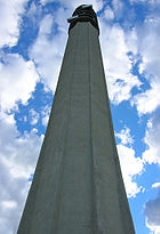
Aliant Tower
Encyclopedia
The Bell Aliant Tower, formerly known as the Aliant Tower and older still, the NBTel Tower, is a 127 metre high tower of reinforced concrete
located in Moncton, New Brunswick
, Canada
. It is used to provide directional radio
services. It is the tallest radio tower in Atlantic Canada
.
During the construction phase of the tower, only two people ever stood on top of the red beacon at the top of the tower, Bob Sweet and John Brophi, both were engineers on the project.
The tower is not used as much today as it was through the '70s, '80s and early '90s because of the dwindling popularity of microwave transmission equipment but is still used for modern cell phone communications, 3G internet devices and emergency radio services such as those used by the RCMP and fire departments. As of late 2010 and early 2011 the tower has been undergoing structural reinforcement through the use of Fibrwrap, a durable yet thin fiberglass coating designed to protect and seal the concrete structure to help lengthen the life of the structure and protect it from the hard climates sometimes present in atlantic Canada.
Reinforced concrete
Reinforced concrete is concrete in which reinforcement bars , reinforcement grids, plates or fibers have been incorporated to strengthen the concrete in tension. It was invented by French gardener Joseph Monier in 1849 and patented in 1867. The term Ferro Concrete refers only to concrete that is...
located in Moncton, New Brunswick
New Brunswick
New Brunswick is one of Canada's three Maritime provinces and is the only province in the federation that is constitutionally bilingual . The provincial capital is Fredericton and Saint John is the most populous city. Greater Moncton is the largest Census Metropolitan Area...
, Canada
Canada
Canada is a North American country consisting of ten provinces and three territories. Located in the northern part of the continent, it extends from the Atlantic Ocean in the east to the Pacific Ocean in the west, and northward into the Arctic Ocean...
. It is used to provide directional radio
Radio
Radio is the transmission of signals through free space by modulation of electromagnetic waves with frequencies below those of visible light. Electromagnetic radiation travels by means of oscillating electromagnetic fields that pass through the air and the vacuum of space...
services. It is the tallest radio tower in Atlantic Canada
Atlantic Canada
Atlantic Canada is the region of Canada comprising the four provinces located on the Atlantic coast, excluding Quebec: the three Maritime provinces – New Brunswick, Prince Edward Island, and Nova Scotia – and Newfoundland and Labrador...
.
History
The NBTel Tower was the subject of litigation in John Maryon Int Ltd v. NB Telephone Co [1982] N.B.J. No. 387 (N.B. C.A.). In his decision on the case, Justice LaForest provided substantial background on the early history of the tower:- In early 1970 the New Brunswick Telephone Company, Limited (N.B.Tel) learned that plans had been approved by the City of Moncton for the construction of the Place L'Assomption development, a new high-rise business complex in the heart of the city. This development would block the transmission of microwave messages to and from N.B.Tel's 135 feet steel tower located in downtown Moncton. As a result, N.B.Tel decided to build a new and higher tower, and in June 1970 it invited several consulting engineers to submit proposals for the construction of the new tower.
- John Maryon International Ltd. (Maryon International) was selected as consultant to design and arrange for its construction.
- Construction work had in fact already started on September 21, 1970, when excavation for the foundation was begun. The slip form method of construction, whereby concrete is poured into forms continuously moving upwards, was recommended and used in constructing the tower shaft. The slip form began on November 4, 1970, and was finished on November 20, 1970. Other aspects of the work proceeded with similar celerity, and the tower was completed and fully operational by the following summer. It was officially opened at the beginning of June 1971.
During the construction phase of the tower, only two people ever stood on top of the red beacon at the top of the tower, Bob Sweet and John Brophi, both were engineers on the project.
Use Today
The tower has become an icon of the city since its construction because of unique design. In most print media that involves the depiction of the City of Moncton almost always features some depiction of the tower. To many, it is also the first thing that is noticed when approaching the city from the ground or air because of its height and lack of competition on the skyline. In the past, it was easily noticed by city residents because the satellites and openings that surround the top of the tower would be lit up after dark, but because of recent budget cuts and lack of use, Bell Aliant no longer lights the tower up to save on electricity and maintenance costs.The tower is not used as much today as it was through the '70s, '80s and early '90s because of the dwindling popularity of microwave transmission equipment but is still used for modern cell phone communications, 3G internet devices and emergency radio services such as those used by the RCMP and fire departments. As of late 2010 and early 2011 the tower has been undergoing structural reinforcement through the use of Fibrwrap, a durable yet thin fiberglass coating designed to protect and seal the concrete structure to help lengthen the life of the structure and protect it from the hard climates sometimes present in atlantic Canada.

